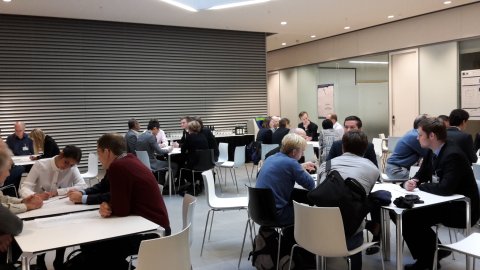11:00
11:00
JOINT LOGIC/PHILOSOPHY OF MATHEMATICS SEMINAR: Modal Logics of multiverses
Abstract
If you fix a class of models and a construction method that allows you to construct a new model in that class from an old model in that class, you can consider the Kripke frame generated from any given model by iterating that construction method and define the modal logic of that Kripke frame. We shall give a general definition of these modal logics in the fully abstract setting and then apply these ideas in a number of cases. Of particular interest is the case where we consider the class of models of ZFC with the construction method of forcing: in this case, we are looking at the so-called "generic multiverse".
16:00
Quasihomomorphisms with non-commutative target
Abstract
Quasihomomorphisms (QHMs) are maps $f$ between groups such that the
homomorphic condition is boundedly satisfied. The case of QHMs with
abelian target is well studied and is useful for computing the second
bounded cohomology of groups. The case of target non-abelian has,
however, not been studied a lot.
We will see a technique for classifying QHMs $f: G \rightarrow H$ by Fujiwara and
Kapovich. We will give examples (sometimes with proofs!) for QHM in
various cases such as
- the image $H$ hyperbolic groups,
- the image $H$ discrete rank one isometries,
- the preimage $G$ cyclic / free group, etc.
Furthermore, we point out a relation between QHM and extensions by short
exact sequences.
16:00
Expanders and actions on measure spaces
Abstract
A family of expanders is a sequence of finite graphs which are both sparse and highly connected. Firstly defined in the 80s, they had huge applications in applied maths and computer science. Moreover, it soon turned out that they also had deep implications in pure maths. In this talk I will introduce the expander graphs and I will illustrate a way to construct them by approximating actions of groups on probability spaces.
17:00
Non-Archimedean Analytic Geometry..etc.
Abstract
I want to give an introduction into non-Archimedean Geometry, and show how Model Theory was used to prove the recent results of Hrushovski-Loeser on topological properties of analytic spaces. This may also be of interest with view towards Zilber's programme for syntax-semantics dualities.
Magnitudes of compact sets in euclidean spaces: an application of analysis to the theory of enriched categories
Abstract
Leinster and Willerton have introduced the concept of the magnitude of a metric space, as a special case as that of an enriched category. It is a numerical invariant which is designed to capture the important geometric information about the space, but concrete examples of ts values on compact sets in euclidean space have hitherto been lacking. We discuss progress in some conjectures of Leinster and Willerton.


